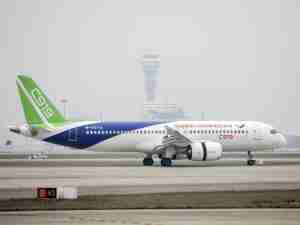General Electric Co. beat Wall Street’s expectations for second-quarter profit and reported surprise positive cash flow as sales at the key jet-engine division soared, buoying the conglomerate despite supply woes that continue to pressure the balance sheet.
GE Aerospace’s sales jumped 27% while orders climbed 26% in the period, the company said Tuesday in a statement, as rebounding travel boosted demand. That helped push the parent company’s profit to 78 cents a share, easily outpacing the 37-cent average of analysts’ estimates compiled by Bloomberg.
“While the topline strength was broad-based across the segments, aviation was the standout this quarter as the commercial recovery continues to climb,” Deane Dray, an analyst with RBC Capital Markets, said in a note. He also pointed to free cash flow as a “bright spot.”
The results gave GE a lift even as it cut its cash flow expectations for this year and said it expects a negative impact from insurance accounting changes. While GE is still trending toward the low end of its prior financial forecasts on most metrics, the company said about $1 billion of free cash flow is likely to push out to the future due to supply-chain challenges and sagging renewable energy orders.
“Much is still uncertain about the external pressures companies are facing at this moment,” Chief Executive Officer Larry Culp said in the statement.
The CEO continues to battle inflation, supply woes and sinking demand for wind turbines as he oversees preparations to break up the once-mighty conglomerate beginning next year. Lengthy Covid-19 shutdowns in China and the surging US dollar added to the challenges facing the maker of jet engines, power equipment and hospital scanners.
The shares rose 5.3% at 9:51 a.m. in New York, putting the stock on track for its eighth straight gain. GE fell 28% this year through Monday’s close.
Split On Track
GE’s breakup remains on track, Culp said, with the spinoff of GE Healthcare set for early 2023. GE then plans to combine its energy-related businesses spanning gas-power equipment, wind turbines and digital products and spin those off a year later.
Culp has been overseeing preparations for the spinoffs and recently announced new branding for the businesses once they separate from the conglomerate. GE’s energy-related business, for example, will go by the name GE Vernova, a portmanteau intended to evoke the company’s ambition to offer lower-carbon energy products.
GE’s aviation business -- now known as GE Aerospace -- will continue as the remaining GE entity. Culp recently took on the additional role of CEO of the unit, with John Slattery, who had been CEO since 2020, shifting to the position of chief commercial officer.
Aerospace was a source of strength during the past quarter, Culp said, though he acknowledged that material availability continues to be an issue. The business has faced difficulty delivering engines to customers such as Boeing Co. and Airbus SE.
“They need more engines from us, we want to deliver more engines to them and we couldn’t be more focused on increasing our throughput,” Culp said in an interview.
GE HealthCare’s sales rose about 1% in the quarter while segment profit tumbled 19% amid supply-chain pressures and pandemic-related issues in China.
The renewable energy unit extended its streak of operating losses to 15 consecutive quarters, underscoring the division’s status as the biggest sore spot in GE’s portfolio. Much of the trouble is concentrated within GE’s onshore wind business, which is contending with a major demand downturn in the US.
Free cash flow across the company -- a closely watched measure of underlying profitability -- in the past quarter was $162 million, better than the $864 million outflow expected by analysts.










